�
�
�
�
�
�
� presented by: Pete Mantell of Mantell Motorsport� coverage by: Curtis Jacobson�
� For several years Pete Mantell has been giving British V8 Meet tech-sessions and � also writing articles for this newsletter on the subject of Small Block Ford based MGB � engine conversions. Yes, Pete is expert on that subject... but he also runs a � successful media-blasting and powder-coating business! On Saturday morning at 10am, � Pete presented Powder Coating 101 to a "standing room only" crowd. I think a lot of � people have been curious to hear pointers on powder coating. The information Pete � laid out is relevant and useful to anyone who is either (a) thinking of sending out � some parts to have a durable powder coat finish applied, or (b) thinking of investing � in some equipment and trying their hand at do-it-yourself powder coat finishing. �
� As we've come to expect, Pete was very well prepared. In fact, he handed out literature � packets to all attendees so that we didn't have to take notes! I've reproduced Pete's � prepared notes below, and then at the end I've added some notes anyway from when Pete � got off script and when he got into questions-and-answers.�
�
�
�
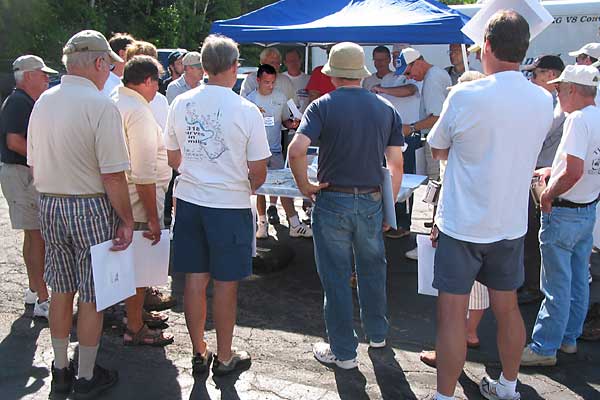
�
Pete Mantell's tech session on powder coating�
British V8 2007 Tech Session: Powder Coating 101
� as published in British V8 Newsletter, Volume XV Issue 2, September 2007�� presented by: Pete Mantell of Mantell Motorsport� coverage by: Curtis Jacobson�
� For several years Pete Mantell has been giving British V8 Meet tech-sessions and � also writing articles for this newsletter on the subject of Small Block Ford based MGB � engine conversions. Yes, Pete is expert on that subject... but he also runs a � successful media-blasting and powder-coating business! On Saturday morning at 10am, � Pete presented Powder Coating 101 to a "standing room only" crowd. I think a lot of � people have been curious to hear pointers on powder coating. The information Pete � laid out is relevant and useful to anyone who is either (a) thinking of sending out � some parts to have a durable powder coat finish applied, or (b) thinking of investing � in some equipment and trying their hand at do-it-yourself powder coat finishing. �
� As we've come to expect, Pete was very well prepared. In fact, he handed out literature � packets to all attendees so that we didn't have to take notes! I've reproduced Pete's � prepared notes below, and then at the end I've added some notes anyway from when Pete � got off script and when he got into questions-and-answers.�
�
�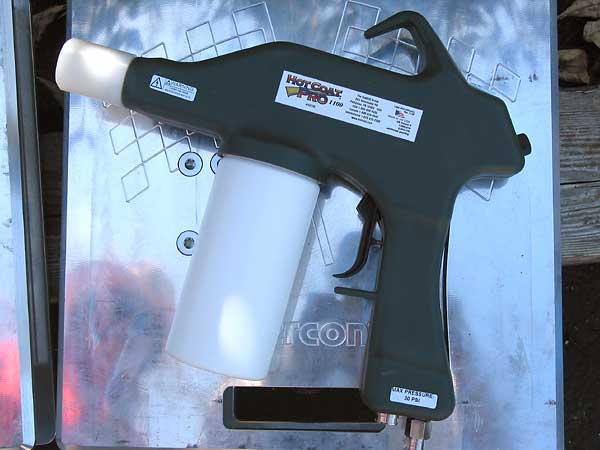
� Pete's HotCoat Pro powder coating gun from Eastwood Company
� Why is powder coating better? �
� It's more durable. Powder coating provides one of the most economical, long-lasting � and color-durable finishes available. Properly powder coated surfaces are more � resistant to chipping, scratching, fading, and wearing than many other alternative � finishes. Color selection is virtually unlimited, and both high and low gloss are � available as well as metallic and clear finishes. Thanks to the UV resistance of � many of the powders, colors stay bright and vibrant longer. Texture selections range � from smooth surfaces to wrinkled and matte finishes. Rougher textures are available � for hiding surface imperfections. �
�
�
�
Pete's Prepared Remarks
� So you've heard of it, but you're not sure exactly what powder coating is. � According to the Powder Coating Institute's web page, "Powder coating is an advanced� method of applying a decorative and protective finish to a wide range of materials � and products that are used by both industries and consumers. The powder used for the � process is a mixture of finely ground particles of pigment and resin, which is sprayed � onto a surface to be coated. The charged powder particles adhere to the electrically � grounded surfaces until heated and fused into a smooth coating in a curing oven. The � result is a uniform, durable, high-quality and attractive finish." There, so now you � know! Or do you? ��

� Pete's HotCoat Pro powder coating gun from Eastwood Company
� Why is powder coating better? �
� It's more durable. Powder coating provides one of the most economical, long-lasting � and color-durable finishes available. Properly powder coated surfaces are more � resistant to chipping, scratching, fading, and wearing than many other alternative � finishes. Color selection is virtually unlimited, and both high and low gloss are � available as well as metallic and clear finishes. Thanks to the UV resistance of � many of the powders, colors stay bright and vibrant longer. Texture selections range � from smooth surfaces to wrinkled and matte finishes. Rougher textures are available � for hiding surface imperfections. �
�
�
Protects the Environment�
� Powder coating is also highly protective of our environment. While liquid finishes contain � solvents which have pollutants known as volatile organic compounds (VOCs), powder coating� contains no solvents and releases negligible amounts, if any, of VOCs into the atmosphere.� Thus, there is no longer a need for finishers to buy costly pollution control equipment. � In addition, most powder coating overspray that does not adhere to the part can be � retrieved and reused. Although this is not always practical for many low-volume users like � me, for some users this can virtually eliminate the waste commonly found in liquid finishing � processes. �
� Saves Money�
� Elimination of VOCs and reduction of wastes saves money and helps companies comply more � easily and economically with the regulations of the U.S. Environmental Protection Agency. � In fact, one of the major elements in expanding the market for powder coating has been � the implementation over the past 30 years of stringent air pollution control legislation.�
�
�
�
� Powder coating is also highly protective of our environment. While liquid finishes contain � solvents which have pollutants known as volatile organic compounds (VOCs), powder coating� contains no solvents and releases negligible amounts, if any, of VOCs into the atmosphere.� Thus, there is no longer a need for finishers to buy costly pollution control equipment. � In addition, most powder coating overspray that does not adhere to the part can be � retrieved and reused. Although this is not always practical for many low-volume users like � me, for some users this can virtually eliminate the waste commonly found in liquid finishing � processes. �
� Saves Money�
� Elimination of VOCs and reduction of wastes saves money and helps companies comply more � easily and economically with the regulations of the U.S. Environmental Protection Agency. � In fact, one of the major elements in expanding the market for powder coating has been � the implementation over the past 30 years of stringent air pollution control legislation.�
�
�
Where is Powder Coating Used?�
� The appliance and architectural supply industries have been leaders, but the automotive� industry is also a big user of powder coating. Conversion from liquid to powder clearcoats � for auto body exteriors is moving rapidly. Powder topcoats resist acid rain, the sun's � ultraviolet rays and road and weather damage, helping cars retain their "showroom look" � much longer and improving their resale value. BMW and Volvo are using powder coating on � some of their new model cars. GM, Ford and Daimler-Chrysler have formed a consortium to � test this technique on production lines. �
� Powder coating has made substantial inroads as a primer for car, van, and pickup truck � bodies in the United States. Auto body primers in colors will be next. �
� There is a huge potential market for high-heat resistant powder coatings on aftermarket � mufflers, to resist corrosion, protect against nicks, and prolong the life of the muffler. � Some companies are already applying heat-resistant powder to aftermarket mufflers, and � the new car market is thought to be two or three years away. �
� Powder coating is also applied to wheels, grilles, bumpers, door handles, roof racks, and � exterior and interior trim. "Under the hood" uses include oil and fuel filters, brake pads, � engine block casings, suspension components and radiators. Pickup truck and SUV owners � purchase powder coated side steps, bed rails, luggage racks, and toolboxes as dealership � add-ons or in aftermarket stores and catalogs.�
� Performance car owners can find powder coated special suspension units, carburetor parts � and valve covers, plus flashy rear view mirror mounts and other exterior adornments.�
�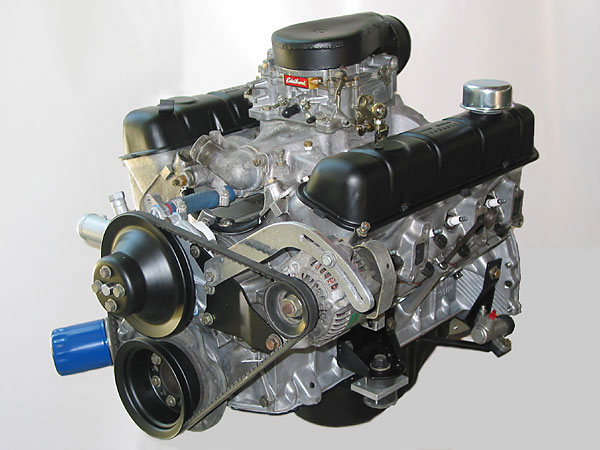
� All of the satin black components in this picture were media blasted and powder coated by Pete.
� If you're not familiar with the term "media blasting", just think "sand blasting" except � that the abrasive particles used aren't necessarily sand. In fact, Pete said he uses glass � bead abrasive powder for almost everything he media blasts. (There are certain situations � where other media such as crushed walnut shells or aluminum oxide grit work better, � but glass bead is the most versatile of media. Incidentally, Pete specifically warned � "Don't ever use aluminum oxide grit to blast aluminum because the grit gets imbedded � and is about impossible to remove. You can't get a smooth powder coat finish over the � aluminum oxide grit.)�
� Pete showed us a couple engine valve covers. One of them he had challenged his apprentice � to clean as thoroughly and carefully as he could with chemical degreasers. Even after � scrubbing and scrubbing, apparently the valve cover wasn't truly clean because when � Pete applied a powder coating over it, the finish was horrible: blotchy, discolored, and � with uneven smoothness. �
� After media blasting, dust needs to be removed from the substrate. You can wipe it off with a rag. � Eastwood's "PRE", which comes in an aerosol can, is handy at this stage because it will also � remove any traces of dirt, wax, grease, or silicone that may remain on the surface. �
� What about masking? First of all, special masking tape is available that's designed � specifically to withstand the heat of the powder coating oven and still be removable. � With masking tape it's possible (although difficult) to layer up multiple colors of � powder coating. On the other hand, one of the charms of powder coating is that masking � is typically a bit less of an issue than with paints. After applying the powder, but � before heating in the oven, the powder (e.g. "overspray") can simply be wiped off of � any surface where it's not wanted. �
� Although people don't seem to talk about it so much, you can also use familiar techniques � to "improve" the powder coat finish after it cures: buffing, color sanding, etc.�
��
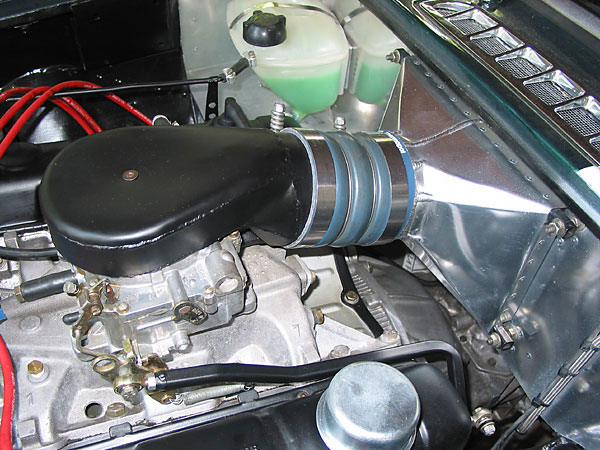
� Eastwood epoxy powder, color code number 11869 "flat black", as applied by Mantell Motorsport
�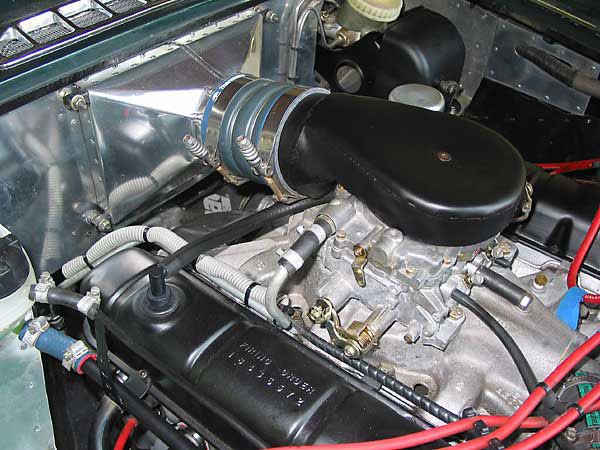
� Engine compartment parts, suspension parts, brake system parts...
� �
Editor's note: I hired Pete to blast and powder-coat a big batch of MGB V8�
parts for me this summer. The finish completely met my expectation, as I knew �
it would. Even more important to me, Pete provides exceptional, quick, hassle-free �
service. Great communication and careful packaging too. Give Pete a call when �
you need something powdercoated!�
� Disclaimer: This page was researched and written by Curtis Jacobson. Views expressed � are those of the author, and are provided without warrantee or guarantee. Apply at your own risk.�
� Photos by Curtis Jacobson. All rights reserved. �
�
�
� The appliance and architectural supply industries have been leaders, but the automotive� industry is also a big user of powder coating. Conversion from liquid to powder clearcoats � for auto body exteriors is moving rapidly. Powder topcoats resist acid rain, the sun's � ultraviolet rays and road and weather damage, helping cars retain their "showroom look" � much longer and improving their resale value. BMW and Volvo are using powder coating on � some of their new model cars. GM, Ford and Daimler-Chrysler have formed a consortium to � test this technique on production lines. �
� Powder coating has made substantial inroads as a primer for car, van, and pickup truck � bodies in the United States. Auto body primers in colors will be next. �
� There is a huge potential market for high-heat resistant powder coatings on aftermarket � mufflers, to resist corrosion, protect against nicks, and prolong the life of the muffler. � Some companies are already applying heat-resistant powder to aftermarket mufflers, and � the new car market is thought to be two or three years away. �
� Powder coating is also applied to wheels, grilles, bumpers, door handles, roof racks, and � exterior and interior trim. "Under the hood" uses include oil and fuel filters, brake pads, � engine block casings, suspension components and radiators. Pickup truck and SUV owners � purchase powder coated side steps, bed rails, luggage racks, and toolboxes as dealership � add-ons or in aftermarket stores and catalogs.�
� Performance car owners can find powder coated special suspension units, carburetor parts � and valve covers, plus flashy rear view mirror mounts and other exterior adornments.�
�

� All of the satin black components in this picture were media blasted and powder coated by Pete.
Pete's Extemporaneous Remarks
� The main, recurring topic of the Pete's remarks was regarding the importance of � properly preparing all surfaces before powder coating. If the underlying surface is � dirty, rough, or uneven, you must expect inferior results. Almost all the parts � Pete powder coats first get media blasted. �� If you're not familiar with the term "media blasting", just think "sand blasting" except � that the abrasive particles used aren't necessarily sand. In fact, Pete said he uses glass � bead abrasive powder for almost everything he media blasts. (There are certain situations � where other media such as crushed walnut shells or aluminum oxide grit work better, � but glass bead is the most versatile of media. Incidentally, Pete specifically warned � "Don't ever use aluminum oxide grit to blast aluminum because the grit gets imbedded � and is about impossible to remove. You can't get a smooth powder coat finish over the � aluminum oxide grit.)�
� Pete showed us a couple engine valve covers. One of them he had challenged his apprentice � to clean as thoroughly and carefully as he could with chemical degreasers. Even after � scrubbing and scrubbing, apparently the valve cover wasn't truly clean because when � Pete applied a powder coating over it, the finish was horrible: blotchy, discolored, and � with uneven smoothness. �
� After media blasting, dust needs to be removed from the substrate. You can wipe it off with a rag. � Eastwood's "PRE", which comes in an aerosol can, is handy at this stage because it will also � remove any traces of dirt, wax, grease, or silicone that may remain on the surface. �
� What about masking? First of all, special masking tape is available that's designed � specifically to withstand the heat of the powder coating oven and still be removable. � With masking tape it's possible (although difficult) to layer up multiple colors of � powder coating. On the other hand, one of the charms of powder coating is that masking � is typically a bit less of an issue than with paints. After applying the powder, but � before heating in the oven, the powder (e.g. "overspray") can simply be wiped off of � any surface where it's not wanted. �
� Although people don't seem to talk about it so much, you can also use familiar techniques � to "improve" the powder coat finish after it cures: buffing, color sanding, etc.�
�

� Eastwood epoxy powder, color code number 11869 "flat black", as applied by Mantell Motorsport
�

� Engine compartment parts, suspension parts, brake system parts...
�
� Disclaimer: This page was researched and written by Curtis Jacobson. Views expressed � are those of the author, and are provided without warrantee or guarantee. Apply at your own risk.�
� Photos by Curtis Jacobson. All rights reserved. �

